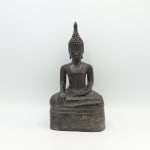Bronze Statue of a Seated Buddha, 16th Century CE
Bronze
height 27 cm
height 10 5/8 in
height 10 5/8 in
AB.036
Further images
Serene simplicity characterises this Buddha figure, seated in a half-lotus position atop a thick platform with his right foot resting on his left knee. He possesses several characteristic features of...
Serene simplicity characterises this Buddha figure, seated in a half-lotus position atop a thick platform with his right foot resting on his left knee. He possesses several characteristic features of Buddha depictions, including his tightly-curled hair, ushnisha and elongated earlobes. The ushnisha is a protuberance on the top of the head which is one of the Buddha’s key characteristics and which symbolises his enlightenment. In this example the shape of the ushnisha is reminiscent of a Burmese stupa, a religious structure that usually houses Buddhist relics. Within East Asian belief, particularly Buddhism, large ears are seen as a sign of wisdom and compassion. The Buddha is often depicted with elongated ears to symbolise his ability to hear the cries of those who are suffering, and his sympathy and willingness to help ease their pain. It is therefore a comforting image, as it reminds those who see it that there is hope for an end to their sufferings through the search for enlightenment and the compassion of those who have reached it. His clothing is indicated only by the striped borders at its edges, showing that it is plain and insignificant. This is a reminder that he has given up any desire for elaborate material possessions. His serene expression, with closed eyes and a gentle smile, conveys the sense of inner peace that he has been able to achieve.
The Buddha’s hands are held in the Bhumisparsha mudra, with his right hand reaching downwards across his right knee towards the ground, and his left resting face-up over his legs. ‘Mudra’ literally means ‘seal’ or ‘gesture’ and is used to refer to a pose, usually of the hands, which has a symbolic meaning and connection to an event in the life of the Buddha. The Bhumisparsha or ‘earth witness’ mudra represents the connection which the Buddha made with the earth when he was close to achieving Nirvana. The demon Mara was trying to frighten him and interrupt his meditation, and as part of this challenged him to produce a witness to agree that he had the right to achieve enlightenment. As the Buddha touched the ground, the earth itself appeared as his witness, allowing him to defeat Mara and prove himself worthy of reaching Nirvana.
The Buddha’s hands are held in the Bhumisparsha mudra, with his right hand reaching downwards across his right knee towards the ground, and his left resting face-up over his legs. ‘Mudra’ literally means ‘seal’ or ‘gesture’ and is used to refer to a pose, usually of the hands, which has a symbolic meaning and connection to an event in the life of the Buddha. The Bhumisparsha or ‘earth witness’ mudra represents the connection which the Buddha made with the earth when he was close to achieving Nirvana. The demon Mara was trying to frighten him and interrupt his meditation, and as part of this challenged him to produce a witness to agree that he had the right to achieve enlightenment. As the Buddha touched the ground, the earth itself appeared as his witness, allowing him to defeat Mara and prove himself worthy of reaching Nirvana.











